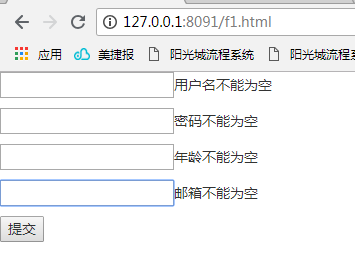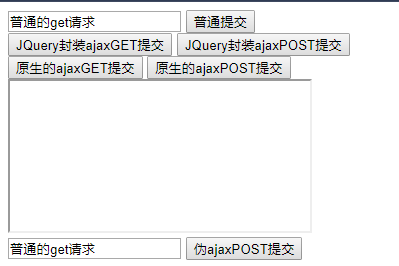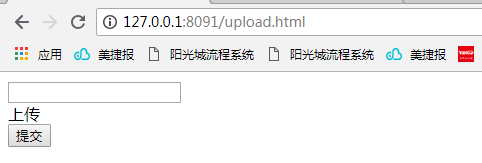Django的Form主要具有一下几大功能:
- 生成HTML标签
- 验证用户数据(显示错误信息)
- HTML Form提交保留上次提交数据
- 初始化页面显示内容
后台逻辑(导包+建类)

from django.shortcuts import render,redirect,HttpResponse from django import forms from django.forms import fields class F1Form(forms.Form): user=fields.CharField( required=True, min_length=6, max_length=16, error_messages={ 'required':'用户名不能为空', 'min_length':'至少为6个字符', 'max_length': '最多为16个字符', } ) pwd = fields.CharField( required=True, min_length=6, max_length=16, error_messages={ 'required': '密码不能为空', 'min_length': '至少为6个字符', 'max_length': '最多为16个字符', } ) age = fields.IntegerField( required=True, error_messages={ 'required': '年龄不能为空', 'invalid': '年龄格式不正确', } ) email = fields.EmailField( required=True, min_length=6, max_length=18, error_messages={ 'required': '邮箱不能为空', 'min_length': '至少为6个字符', 'max_length': '最多为18个字符', 'invalid': '邮箱格式不正确', } ) def f1(request): if request.method=="GET": obj=F1Form() return render(request,'f1.html',{'obj':obj}) else: obj = F1Form(request.POST) # 校验是否成功 if obj.is_valid(): return redirect('http://www.baidu.com') else: return render(request,'f1.html',{'obj':obj})

<!DOCTYPE html> <html lang="en"> <head> <meta charset="UTF-8"> <title>Title</title> <link rel="stylesheet" href="/static/plugins/bootstrap/css/bootstrap.css"> </head> <body> <form id="fm" action="/f1.html" method="POST"> <p>{{obj.user}}{{ obj.errors.user.0 }}</p> <p>{{obj.pwd}}{{ obj.errors.pwd.0 }}</p> <p>{{obj.age}}{{ obj.errors.age.0 }}</p> <p>{{obj.email}}{{ obj.errors.email.0 }}</p> <input type="submit" value="提交"/> </form> <script src="/static/js/jquery-3.3.1.min.js"></script> </body> </html>

小试牛刀:实现一套“增删改”
1:创建Model模型并生成数据表

from django.db import models # Create your models here. class UserInfo(models.Model): username=models.CharField(max_length=16) email = models.EmailField(max_length=16)
2:创建Form文件

from django import forms from django.forms import fields class UserInfoForm(forms.Form): username = forms.CharField( required=True, max_length=16, error_messages={ "required": "姓名不能为空", "max_length": '姓名最大长度不能超过16位' } ) email = forms.EmailField( required=True, min_length=6, error_messages={ "required": "邮箱不能为空", "min_length": '邮箱最小长度不能低于6位', "invalid":"邮箱格式不正确" })
3:创建View文件并修改url配置

from django.shortcuts import render, redirect, HttpResponse from App01.models import UserInfo from App01.Forms.UserInfo import UserInfoForm def user_list(request): # 获取用户信息列表 obj = UserInfo.objects.all() return render(request, "FormTest/user_list.html", {"obj": obj}) def user_add(request): # 添加用户 if request.method == 'GET': obj = UserInfoForm() return render(request, "FormTest/user_add.html", {"obj": obj}) else: obj = UserInfoForm(request.POST) if obj.is_valid(): UserInfo.objects.create(**obj.cleaned_data) return redirect('/user_list') else: return render(request, "FormTest/user_add.html", {"obj": obj}) def user_edit(request,nid): # 编辑用户 if request.method == 'GET': enti = UserInfo.objects.filter(id=nid).first() obj = UserInfoForm({"username":enti.username,"email":enti.email}) return render(request, "FormTest/user_edit.html", {"obj": obj,"nid":nid}) else: obj = UserInfoForm(request.POST) if obj.is_valid(): UserInfo.objects.filter(id=nid).update(**obj.cleaned_data) return redirect('/user_list') else: return render(request, "FormTest/user_edit.html", {"obj": obj, "nid": nid}) def user_del(request): # 删除用户 if request.method=='GET': nid = request.GET.get("nid") UserInfo.objects.filter(id=nid).delete() return redirect("/user_list")

"""StudyForm URL Configuration The `urlpatterns` list routes URLs to views. For more information please see: https://docs.djangoproject.com/en/2.1/topics/http/urls/ Examples: Function views 1. Add an import: from my_app import views 2. Add a URL to urlpatterns: path('', views.home, name='home') Class-based views 1. Add an import: from other_app.views import Home 2. Add a URL to urlpatterns: path('', Home.as_view(), name='home') Including another URLconf 1. Import the include() function: from django.urls import include, path 2. Add a URL to urlpatterns: path('blog/', include('blog.urls')) """ from django.contrib import admin from django.urls import path from django.conf.urls import url from App01.Views import FormTest urlpatterns = [ path('admin/', admin.site.urls), url(r'^user_list', FormTest.user_list), url(r'^user_add', FormTest.user_add), url(r'^user_edit-(\d+)', FormTest.user_edit), url(r'^user_del', FormTest.user_del), ]
4:HTML页面

<!DOCTYPE html> <html lang="en"> <head> <meta charset="UTF-8"> <title>Title</title> </head> <body> <a href="/user_add">添加</a> <table id="tbStudentsList" class="table table-hover table-bordered"> <thead> <tr> <th>ID</th> <th>姓名</th> <th>邮箱</th> <th>操作</th> </tr> </thead> <tbody> {% for row in obj %} <tr nid="{{ row.id }}"> <td>{{ row.id }}</td> <td>{{ row.username }}</td> <td>{{ row.email }}</td> <td> <a href="user_edit-{{ row.id }}">修改</a> | <a href="user_del?nid={{ row.id }}">删除</a> </td> </tr> {% endfor %} </tbody> </table> </body> </html>

<!DOCTYPE html> <html lang="en"> <head> <meta charset="UTF-8"> <title>Title</title> </head> <body> <form action="/user_add/" method="post" novalidate> {% csrf_token %} <p>{{ obj.username }}{{ obj.errors.username.0 }}</p> <p>{{ obj.email }}{{ obj.errors.email.0 }}</p> <input type="submit" value="提交"/> </form> </body> </html>

<!DOCTYPE html> <html lang="en"> <head> <meta charset="UTF-8"> <title>Title</title> </head> <body> <form action="/user_edit-{{ nid }}/" method="post" novalidate> {% csrf_token %} <p>{{ obj.username }}{{ obj.errors.username.0 }}</p> <p>{{ obj.email }}{{ obj.errors.email.0 }}</p> <input type="submit" value="提交"/> </form> </body> </html>


三种ajax请求(jQuery封装后的ajax+原生的ajax+伪ajax(form+iframe))

"""StudyForm URL Configuration The `urlpatterns` list routes URLs to views. For more information please see: https://docs.djangoproject.com/en/2.1/topics/http/urls/ Examples: Function views 1. Add an import: from my_app import views 2. Add a URL to urlpatterns: path('', views.home, name='home') Class-based views 1. Add an import: from other_app.views import Home 2. Add a URL to urlpatterns: path('', Home.as_view(), name='home') Including another URLconf 1. Import the include() function: from django.urls import include, path 2. Add a URL to urlpatterns: path('blog/', include('blog.urls')) """ from django.contrib import admin from django.urls import path from django.conf.urls import url from App01.Views import FormTest,UploadTest,AjaxTest urlpatterns = [ path('admin/', admin.site.urls), url(r'^user_list', FormTest.user_list), url(r'^user_add', FormTest.user_add), url(r'^user_edit-(\d+)', FormTest.user_edit), url(r'^user_del', FormTest.user_del), # 文件上传 url(r'^upload.html$', UploadTest.upload), #Ajax练习 # 一、普通的form提交+jQuery封装后的Ajax url(r'^ajax1.html$', AjaxTest.ajax1), url(r'^ajax11.html$', AjaxTest.ajax11), #二、原生态的Ajax url(r'^ajax2.html$', AjaxTest.ajax2), #三、伪Ajax(form+iframe) url(r'^ajax3.html$', AjaxTest.ajax3), # 文件上传 url(r'^ajaxUpload$', AjaxTest.ajaxUpload), ]

<!DOCTYPE html> <html lang="en"> <head> <meta charset="UTF-8"> <title>Title</title> <script type="text/javascript" src="/static/js/jquery-3.3.1.min.js"></script> </head> <body> {% csrf_token %} <form action="ajax1.html" method="post"> <input type="text" id="ajaxText" name="ajaxText" placeholder="请输入测试数据" value="{{ qMethod }}"> <input type="submit" value="普通提交"> <br/> <input type="button" value="JQuery封装ajaxGET提交" onclick="ajax1Get()"> <input type="button" value="JQuery封装ajaxPOST提交" onclick="ajax1Post()"> <br/> <input type="button" value="原生的ajaxGET提交" onclick="nativeAjax1Get()"> <input type="button" value="原生的ajaxPOST提交" onclick="nativeAjax1Post()"> <br/> </form> <iframe id="iframe" name="ifra"></iframe> <form id="fm" action="/ajax3.html" method="POST" target="ifra"> <input type="text" id="aText" name="aText" placeholder="请输入测试数据" value="{{ qMethod }}"> <input type="button" value="伪ajaxPOST提交" onclick="fakeAjax1Post()"> <br/> </form> <hr/> <iframe id="uploadFR" name="uploadFR" style="display: none"></iframe> <form id="uploadFM" name="uploadFM" method="post" action="ajaxUpload" enctype="multipart/form-data" target="uploadFR"> <input type="file" id="img" name="val"> <input type="button" value="通过ajax+formData上传" onclick="upload1()"> <input type="button" value="通过原生xhr+formData上传" onclick="upload2()"> <input type="button" value="伪ajax上传" onclick="upload3()"> </form> <script> function ajax1Get() { {#jQuery封装后的ajax-get#} var st = $("#ajaxText").val(); var soft = {'ajaxTest': st} $.ajax({ url: 'ajax11.html', type: 'GET', dataType: 'json', data: soft, success: function (arg) { alert(arg.data) } }) } function ajax1Post() { {#jQuery封装后的ajax-post#} var st = $("#ajaxText").val(); $.ajax({ url: 'ajax11.html', type: 'POST', dataType: 'json', data: {"ajaxTest": st}, success: function (arg) { alert(arg.data) } }) } function nativeAjax1Get() { {#1:创建对象#} var xhr = new XMLHttpRequest() {#2:创建句柄对象#} xhr.onreadystatechange = function () { {#4LoadedHTTP 响应已经完全接收。#} if (xhr.readyState == 4) { alert(xhr.responseText) } } {#3:设置请求方式,指定url路径#} var st = $("#ajaxText").val(); xhr.open("GET", "ajax2.html?ajaxTest=" + st) {#4:发送#} xhr.send() } function nativeAjax1Post() { {#1:创建对象#} var xhr = new XMLHttpRequest() {#2:创建句柄对象#} xhr.onreadystatechange = function () { {#4LoadedHTTP 响应已经完全接收。#} if (xhr.readyState == 4) { alert(xhr.responseText) } } {#3:设置请求方式,指定url路径#} var st = $("#ajaxText").val(); xhr.open("POST", "ajax2.html") xhr.setRequestHeader('Content-Type', 'application/x-www-form-urlencoded; charset-UTF-8'); {#4:发送#} xhr.send("ajaxTest=" + st) } function fakeAjax1Post() { document.getElementById("iframe").onload = reloadIframe; var form1 = document.getElementById('fm'); form1.submit(); } function reloadIframe() { var countent = this.contentWindow.document.body.innerHTML var obj = JSON.parse(countent) if (obj.status) { alert(obj.message) } } function upload1() { var dataForm = new FormData() dataForm.append("val", document.getElementById("img").files[0]) $.ajax({ url: "ajaxUpload", type: "POST", data: dataForm, success: function (arg) { alert("ajax上传文件成功") }, processData: false, // tell jQuery not to process the data contentType: false // tell jQuery not to set contentType }) } function upload2() { var dataForm = new FormData() dataForm.append("val", document.getElementById("img").files[0]) var xhr = new XMLHttpRequest() xhr.onreadystatechange = function () { {#4LoadedHTTP 响应已经完全接收。#} if (xhr.readyState == 4) { alert("原生ajax上传文件成功") } } xhr.open("POST", "ajaxUpload") xhr.send(dataForm) } function upload3(){ document.getElementById("uploadFR").onload=reloadIframe var form1 = document.getElementById('uploadFM'); form1.submit(); } </script> </body> </html>

from django.shortcuts import HttpResponse,render import os,uuid import json def ajax1(request): if request.method=="GET": QMethod='普通的get请求' return render(request,"AjaxTest/ajax1.html",{"qMethod":QMethod}) else: QMethod = '普通的Post请求------'+request.POST.get("ajaxText") return render(request,"AjaxTest/ajax1.html",{"qMethod":QMethod}) def ajax11(request): if request.method=="GET": QMethod = 'Ajax的get请求------' + request.GET.get("ajaxTest") ret = {'status': True, 'data': QMethod, 'message': QMethod} return HttpResponse(json.dumps(ret)) else: QMethod = 'Ajax的Post请求------'+ request.POST.get("ajaxTest") ret = {'status': True, 'data': QMethod, 'message': QMethod} return HttpResponse(json.dumps(ret)) def ajax2(request): if request.method=="GET": QMethod="原生的Ajax的get请求-----"+request.GET.get("ajaxTest") return HttpResponse(QMethod) else: QMethod = "原生的Ajax的post请求-----" + request.POST.get("ajaxTest") return HttpResponse(QMethod) def ajax3(request): if request.method == "GET": QMethod = '伪Ajax的get请求------' + request.GET.get("aText") ret = {'status': True, 'data': QMethod, 'message': QMethod} return render(request, "AjaxTest/ajax1.html", {"qMethod": QMethod}) else: QMethod = '伪Ajax的Post请求------'+request.POST.get("aText") ret = {'status': True, 'data': QMethod, 'message': QMethod} return HttpResponse(json.dumps(ret)) def ajaxUpload(request): # 通过uuid获取到自动编号,防止重复 nid = str(uuid.uuid4()) # 通过request获取上传对象 obj=request.FILES.get("val") # 写文件 file_path=os.path.join("static/files",nid+obj.name) f = open(file_path,'wb') for line in obj.chunks(): f.write(line) f.close() ret = {'status': True, 'data': None, 'message': None} ret["data"]=file_path #返回 return HttpResponse(json.dumps(ret))

附件上传

from django.shortcuts import render, redirect, HttpResponse def upload(request): if request.method=="GET": return render(request, 'UploadTest/upload.html') else: user = request.POST.get("user") img=request.FILES.get('img') f=open(img.name,'wb') for line in img.chunks(): f.write(line) f.close() return render(request, 'UploadTest/upload.html')

<!DOCTYPE html> <html lang="en"> <head> <meta charset="UTF-8"> <title>Title</title> </head> <body> <form action="upload.html" method="post" enctype="multipart/form-data"> {% csrf_token %} <input type="text" name="user"/> <div style="position: relative"> <a>上传</a> <input type="file" name="img" style="opacity: 0;position:absolute;top:0;left: 0;"/> </div> <input type="submit" value="提交"/> </form> </body> </html>

与 三种ajax请求相似,同样存在三种附件上传(代码内容已包含在里面)

Jsonp 示例

<!DOCTYPE html> <html lang="en"> <head> <meta charset="UTF-8"> <title>Title</title> <script src="/static/js/jquery-3.3.1.min.js"></script> </head> <body> <input type="button" value="jsonp测试" onclick="submitJsonp()"/> <script> function submitJsonp() { $.ajax({ {#江西卫视的jsonp只能使用固定的callback函数list()#} {#url: "http://www.jxntv.cn/data/jmd-jxtv2.html",#} url: "https://sug.so.360.cn/suggest", type: 'GET', dataType: 'jsonp', jsonp: 'callback', jsonpCallback: 'func', }) } function func(arg) { alert("可自定义jsonpCallback的函数函数名称") } </script> </body> </html>

from django.shortcuts import HttpResponse,render def jsonp(request): print(1111) return render(request, "JsonpTest/jsonp.html", {"qMethod": "123456"})

